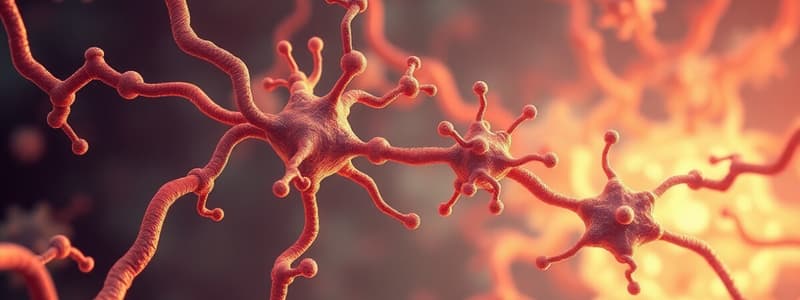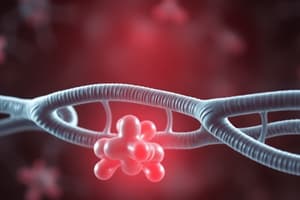Podcast
Questions and Answers
What characterizes an agonist in pharmacodynamics?
What characterizes an agonist in pharmacodynamics?
- It binds irreversibly to the receptor site.
- It does not have any binding capabilities.
- It has both high affinity and high intrinsic activity. (correct)
- It binds to a receptor and produces no response.
Which type of ligand can produce 100% of the maximum possible biological response?
Which type of ligand can produce 100% of the maximum possible biological response?
- Partial agonist
- Antagonist
- Full agonist (correct)
- Chemical antagonist
What does receptor intrinsic activity refer to?
What does receptor intrinsic activity refer to?
- The ability of a ligand to deactivate a receptor.
- The extent to which a ligand activates the receptor. (correct)
- The capacity of a receptor to change shape.
- The effectiveness of a receptor in binding with any ligand.
What type of antagonist competes with the agonist at the same receptor site?
What type of antagonist competes with the agonist at the same receptor site?
What differentiates a partial agonist from a full agonist?
What differentiates a partial agonist from a full agonist?
Which of the following describes a non-competitive antagonist?
Which of the following describes a non-competitive antagonist?
In which scenario would antagonism be abolished by increasing agonist concentration?
In which scenario would antagonism be abolished by increasing agonist concentration?
What is an example of a physiological antagonist?
What is an example of a physiological antagonist?
Which statement is true regarding affinity?
Which statement is true regarding affinity?
What is the primary role of an antagonist in pharmacodynamics?
What is the primary role of an antagonist in pharmacodynamics?
Which of the following statements describes the binding characteristics of a full agonist?
Which of the following statements describes the binding characteristics of a full agonist?
What could be the consequence of a ligand with high affinity but low intrinsic activity?
What could be the consequence of a ligand with high affinity but low intrinsic activity?
How does a non-competitive antagonist differ from a competitive antagonist?
How does a non-competitive antagonist differ from a competitive antagonist?
Which scenario best illustrates the action of a physiological antagonist?
Which scenario best illustrates the action of a physiological antagonist?
What characterizes a chemical antagonist?
What characterizes a chemical antagonist?
In terms of receptor activity, what does high intrinsic activity entail?
In terms of receptor activity, what does high intrinsic activity entail?
What is the common outcome for a ligand with low affinity when binding to its receptor?
What is the common outcome for a ligand with low affinity when binding to its receptor?
How can increasing the concentration of a competitive antagonist affect receptor binding?
How can increasing the concentration of a competitive antagonist affect receptor binding?
Flashcards are hidden until you start studying
Study Notes
Drug Targets
- Drugs target receptors, enzymes, ion channels, carrier molecules, or act via physical/chemical mechanisms.
Drug Receptors
- Highly specific and sensitive binding sites.
- Located on cell membranes or nuclear membranes.
- Receptor specificity: Multiple ligands and associated receptors exist.
Ligand Affinity
- Measures the ligand's ability to bind and remain bound to a receptor.
- High affinity: Strong binding, prolonged activation.
- Low affinity: Weak binding, may not activate receptor.
Receptor Intrinsic Activity
- Measures a ligand's ability to activate the receptor.
- High intrinsic activity: Produces a large effect on the postsynaptic cell.
- Low intrinsic activity: Produces a small or inconsistent effect.
Ligand Classes
- Agonists: High affinity, high intrinsic activity.
- Antagonists: High affinity, low intrinsic activity.
Agonists
- Activate receptors to elicit a response.
- Full agonists: Produce 100% of the maximum biological response.
- Partial agonists: Produce less than 100% of the maximum response, regardless of concentration.
Antagonists
- Bind to receptors without producing a response.
- Types of antagonism: receptor, physiological, chemical.
Receptor Antagonism
- Competitive: Antagonist competes with agonist for the same binding site; reversible; overcome by increased agonist concentration (e.g., antihistamine vs. histamine).
- Non-competitive: Antagonist binds irreversibly to a different site; cannot be overcome by increased agonist concentration (e.g., succinylcholine).
Other Types of Antagonism
- Physiological antagonism: Two compounds with opposing physiological effects (e.g., glucagon and insulin; histamine and epinephrine).
- Chemical antagonism: One drug inactivates another through direct chemical interaction.
Drug Targets
- Drugs act on various targets within the body.
- Main targets include receptors, enzymes, ion channels, carrier molecules.
- Some drugs exert physical or chemical effects.
Drug Receptors
- Receptors are highly specific and sensitive binding sites.
- Located on cell membranes, enzyme molecules, or nuclear membranes.
- Ligands (drug molecules) bind to specific receptors.
Receptor Affinity
- Affinity describes the strength of ligand binding to a receptor.
- High affinity means strong and prolonged binding, leading to receptor activation.
- Low affinity means weak binding, possibly insufficient for activation.
Receptor Intrinsic Activity
- Intrinsic activity measures a ligand's ability to activate a receptor upon binding.
- High intrinsic activity leads to a large effect on the post-synaptic cell.
- Low intrinsic activity results in small or inconsistent effects.
Ligand Classes: Agonists
- Agonists have high affinity and high intrinsic activity.
- Full agonists produce the maximum possible biological response.
- Partial agonists produce less than the maximum response, regardless of concentration.
Ligand Classes: Antagonists
- Antagonists have high affinity but low intrinsic activity; they bind but don't activate.
- Receptor antagonists compete with agonists for the same binding site (competitive) or bind to different sites (non-competitive).
- Competitive antagonism can be overcome by increasing agonist concentration.
- Non-competitive antagonism cannot be overcome by increasing agonist concentration.
Types of Drug Antagonism
- Receptor antagonism: Competitive and non-competitive types exist.
- Competitive: reversible binding at the same site as the agonist.
- Non-competitive: irreversible binding at a different site.
- Physiological antagonism: Two drugs with opposing physiological effects cancel each other out (e.g., glucagon and insulin).
- Chemical antagonism: One drug directly inactivates another through chemical interaction.
Studying That Suits You
Use AI to generate personalized quizzes and flashcards to suit your learning preferences.




